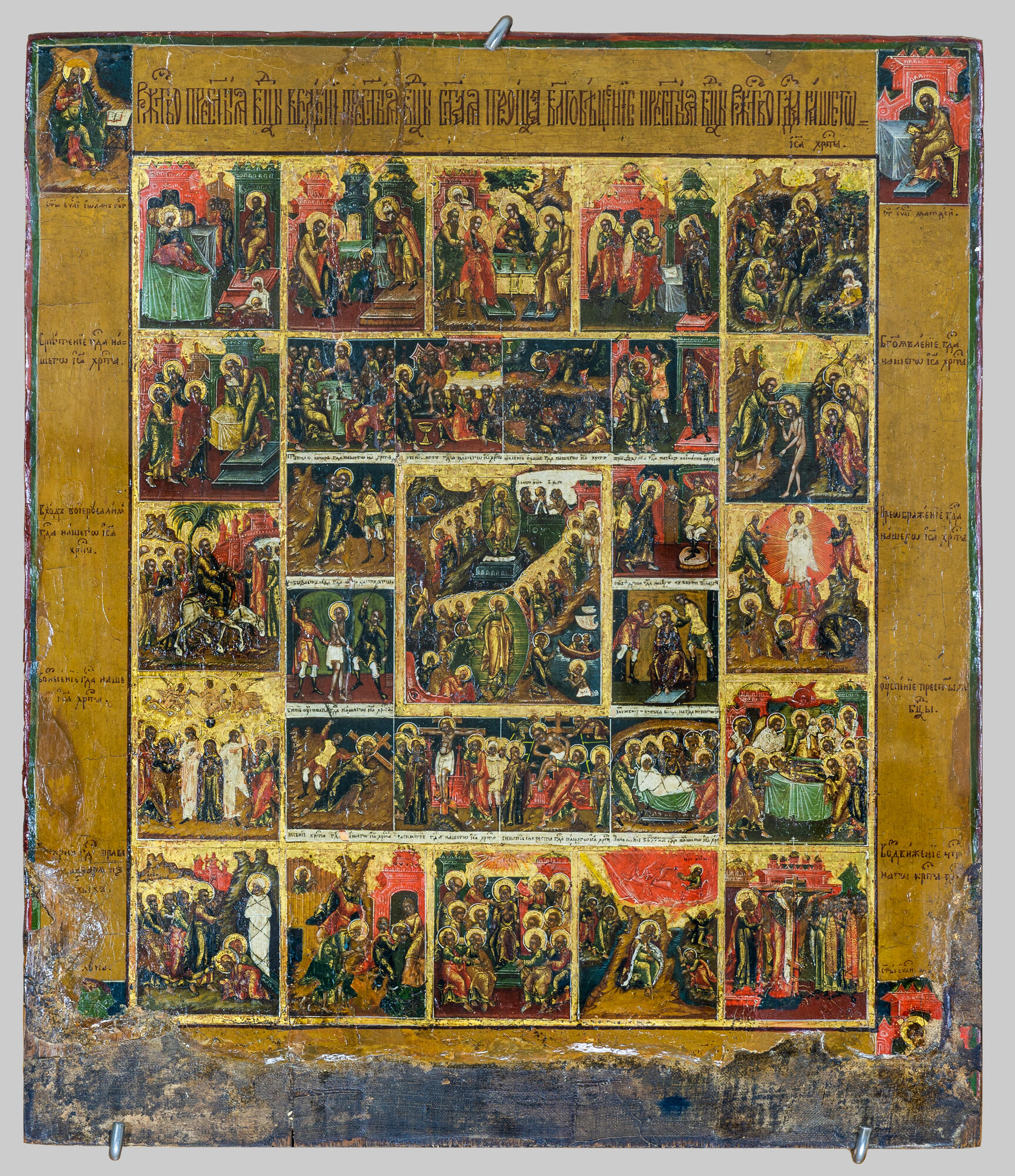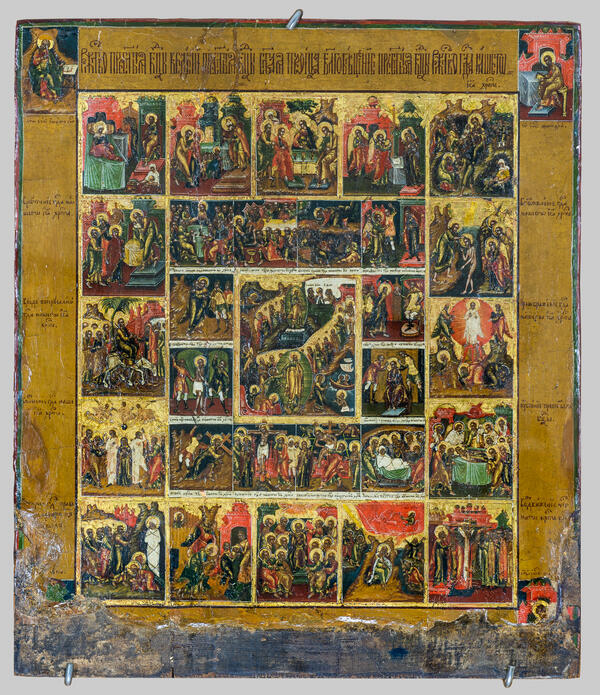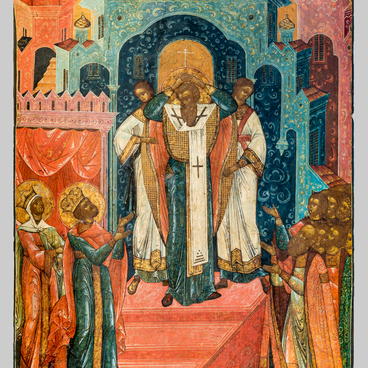The ‘Resurrection — Harrowing of Hell with holidays’ icon was created in the second quarter of the 19th century. It’s painted on a carefully crafted cypress board. This material was imported, and thus rare and expensive.
“Resurrection — Harrowing of Hell” is one of the most common scenes encountered in Palekh icons. Its iconography was based on the Psalms and the apocryphal Gospel of Nikodim. People believe that when He was crucified and His body was rested in the coffin, Saviour’s spirit descended to Hell and lead all the true believers of the Old Testament out. Adam and Eve also escaped with them. Icon painters often cojoin this story with the Resurrection of Christ.
These scenes are found in the composition, one above the other. In each of them, Christ is depicted in full height twice, surrounded by oval glory (the glow symbolizing the manifestation of the divine forces). The upper figure of Christ stands in the coffin on white shrouds. To His right, angels descend towards the entrance to Hell, which is depicted as the fiery cave. One of the angels opens the entrance.
Below, the Saviour holds the gates of Hell open. The mouth of the beast is seen in the lower left corner - it also symbolizes hell. Forefathers and righteous wives emerge from it. Christ holds Adam by the hand. Eve is at the Saviour’s feet.
Among the line of the righteous going to paradise, the author placed angels, as well as the prophets David and Solomon. The closest to the entrance to Heaven is John the Baptist and Dismas the Penitent Thief. Dismas was a criminal, and for that he was crucified on Golgotha — he was dying next to Christ. Having sincerely repented, Dismas accepted the Saviour’s divinity, receiving forgiveness, and ended up in Heaven. The icon depicts the prophets Enoch and Elijah standing in the Garden of Eden and talking to Dismas.
The central composition is surrounded by scenes of the Passions of Christ — events that happened before His Resurrection. The plots of the miniatures correspond to the Gospel of John (chapters 13, 18, and 19) and are arranged in the following order: 1. The Last Supper; 2. Washing of feet; 3. Praying for the cup; 4. Bringing Jesus Christ to trial before the high priest Annas; 5. Kiss of Judas; 6. Bringing Jesus Christ to trial before Pontius Pilate; 7. Flagellation of Jesus Christ; 8. The Crowning with Thorns; 9. Carrying the Cross; 10. Crucifiction; 11. Descent from the Cross; 12 Entombment of Christ.
The order of miniatures does not correspond to the original sequence of events of the Holy Week. Judas' betrayal precedes the trial before High Priest Annas.
Around the scenes from Holy Week, the artist depicted stamps with the holidays, from the Nativity of the Virgin and up to the The Exaltation of the Holy Cross.
On the margins of the icon, the evangelists are shown in miniature stamps in the corners. Top left John the Evangelist. He’s depicted next to a cave. In the right corner, Matthew the Evangelist is depicted against the background of architecture. He sits on a golden chair, resting his legs on the podium. He holds an open golden book. According to the inscriptions, in the lower right corner there was an image of Mark, and in the lower left — an image of Luke, but these parts of the icon have not survived.
“Resurrection — Harrowing of Hell” is one of the most common scenes encountered in Palekh icons. Its iconography was based on the Psalms and the apocryphal Gospel of Nikodim. People believe that when He was crucified and His body was rested in the coffin, Saviour’s spirit descended to Hell and lead all the true believers of the Old Testament out. Adam and Eve also escaped with them. Icon painters often cojoin this story with the Resurrection of Christ.
These scenes are found in the composition, one above the other. In each of them, Christ is depicted in full height twice, surrounded by oval glory (the glow symbolizing the manifestation of the divine forces). The upper figure of Christ stands in the coffin on white shrouds. To His right, angels descend towards the entrance to Hell, which is depicted as the fiery cave. One of the angels opens the entrance.
Below, the Saviour holds the gates of Hell open. The mouth of the beast is seen in the lower left corner - it also symbolizes hell. Forefathers and righteous wives emerge from it. Christ holds Adam by the hand. Eve is at the Saviour’s feet.
Among the line of the righteous going to paradise, the author placed angels, as well as the prophets David and Solomon. The closest to the entrance to Heaven is John the Baptist and Dismas the Penitent Thief. Dismas was a criminal, and for that he was crucified on Golgotha — he was dying next to Christ. Having sincerely repented, Dismas accepted the Saviour’s divinity, receiving forgiveness, and ended up in Heaven. The icon depicts the prophets Enoch and Elijah standing in the Garden of Eden and talking to Dismas.
The central composition is surrounded by scenes of the Passions of Christ — events that happened before His Resurrection. The plots of the miniatures correspond to the Gospel of John (chapters 13, 18, and 19) and are arranged in the following order: 1. The Last Supper; 2. Washing of feet; 3. Praying for the cup; 4. Bringing Jesus Christ to trial before the high priest Annas; 5. Kiss of Judas; 6. Bringing Jesus Christ to trial before Pontius Pilate; 7. Flagellation of Jesus Christ; 8. The Crowning with Thorns; 9. Carrying the Cross; 10. Crucifiction; 11. Descent from the Cross; 12 Entombment of Christ.
The order of miniatures does not correspond to the original sequence of events of the Holy Week. Judas' betrayal precedes the trial before High Priest Annas.
Around the scenes from Holy Week, the artist depicted stamps with the holidays, from the Nativity of the Virgin and up to the The Exaltation of the Holy Cross.
On the margins of the icon, the evangelists are shown in miniature stamps in the corners. Top left John the Evangelist. He’s depicted next to a cave. In the right corner, Matthew the Evangelist is depicted against the background of architecture. He sits on a golden chair, resting his legs on the podium. He holds an open golden book. According to the inscriptions, in the lower right corner there was an image of Mark, and in the lower left — an image of Luke, but these parts of the icon have not survived.



